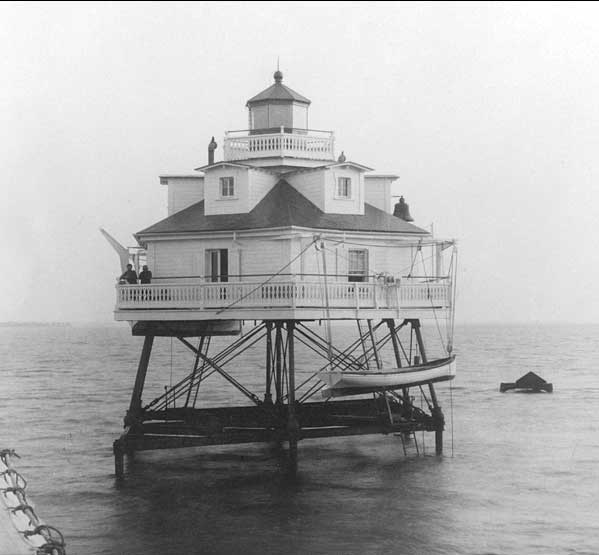Several stretches of cold weather in early January 1877 froze the Chesapeake Bay solid, and for multiple days the Port of Baltimore was under an ice embargo—no major ship traffic could move in or out of the port. As many as 500 ships sheltered at Annapolis where the Baltimore Sun reported, “From Greenbury Point to Annapolis... the vessels were so thickly strung that one could walk from deck to deck to the city... the dense forest of masts almost obscured the ancient city from view.”

Forty-five miles to the south of Annapolis, ice floes severely damaged the Hooper Strait Lighthouse on January 11. The Hooper Strait cottage toppled into the Bay and floated more than four miles southward with the ice floe. The Hooper Strait keepers escaped and were discovered on a small island by a rescue party 24 hours later.
By Sunday, January 14, the ice had broken up to the point of allowing some passage through the Bay. Out at the end of the Thomas Point Shoal, aboard the screwpile lighthouse, Keeper Eugene Burchenal and his assistant, Charles Miller, felt the warming of the air and could see and hear the ice breaking up around the station. As the Bay came alive with ship traffic, their lamp would be more important than ever. Captain Miller’s wife and their teenage son were also aboard the station with the keepers.
As the air warmed and a steady northwesterly wind blew in, the ice began moving, predominantly from north to south. Heavy ice slammed against the Thomas Point screwpile base, vibrating the structure and producing violent sounds. As the piles and beams beneath it were shifted by the ice floe, the cottage began to lean over. Burchenal and the Millers feverishly worked to stabilize the equipment inside the cottage. The stove was lashed down. Containers of lamp fuel turned over and spilled noxious liquid across the cottage floor. The angle of lean increased, and the clapper of the station’s fog bell lay useless on the side of the bell.
On Tuesday, January 16, the fourth day of the siege, the vibration and crashing grew so strong that the station’s Fresnel lens, weighing upward of 500 pounds, fell off its base and was damaged. Undeterred and aware of their duty as keepers, Burchenal and Miller rigged a replacement light in a window.

The following day, Wednesday, January 17, the assault from the ice continued, and Burchenal made the call: it was too dangerous to stay aboard. Living conditions inside the house, after five full days of ice assault, had worn down the tired group. The cold returned, and it was snowing. The lens was damaged, equipment and gear were strewn about, and one of the screwpiles had broken. More of the supporting screwpiles looked vulnerable. The lighthouse leaned farther and farther at a wild angle.
Amid this chaos, Burchenal sat down and wrote a letter to officials with the Lighthouse Board’s Fifth District: “I regret to report that the ice came down on the house in very heavy fields... Some of the ice over two feet thick... the lens was turned over and broken to pieces... I will try to stick to the house until further order.”
The group bravely stuck it out through late afternoon of the next day before loading equipment into one of the station’s tenders and voyaging more than a mile west through a moving field of drift ice to the shoreline at the Thomas Point peninsula.
On shore, the old stone lighthouse tower, which had been abandoned just two years earlier, still stood on the point, although high tides now swirled cold around its base. The keeper and his assistant climbed to the top of the tower, and as evening approached, they lit a lamp at its top. Only then did Eugene Burchenal add a postscript to his letter: “January 18th captain left the light house at four o’clock p.m. This afternoon started the light at the old light station on shore to night will keep a light there until ordered to discontinue.”
By Dave Gendell